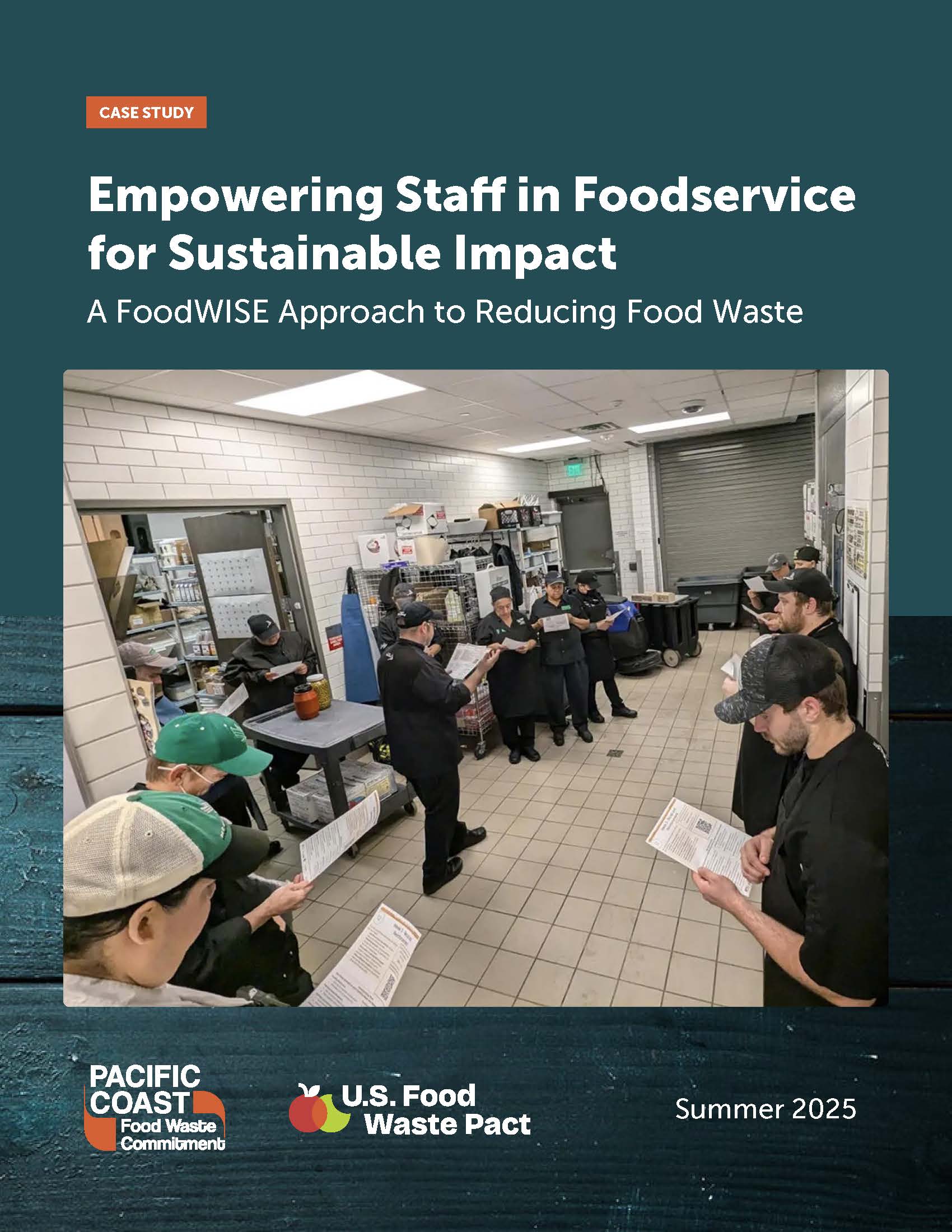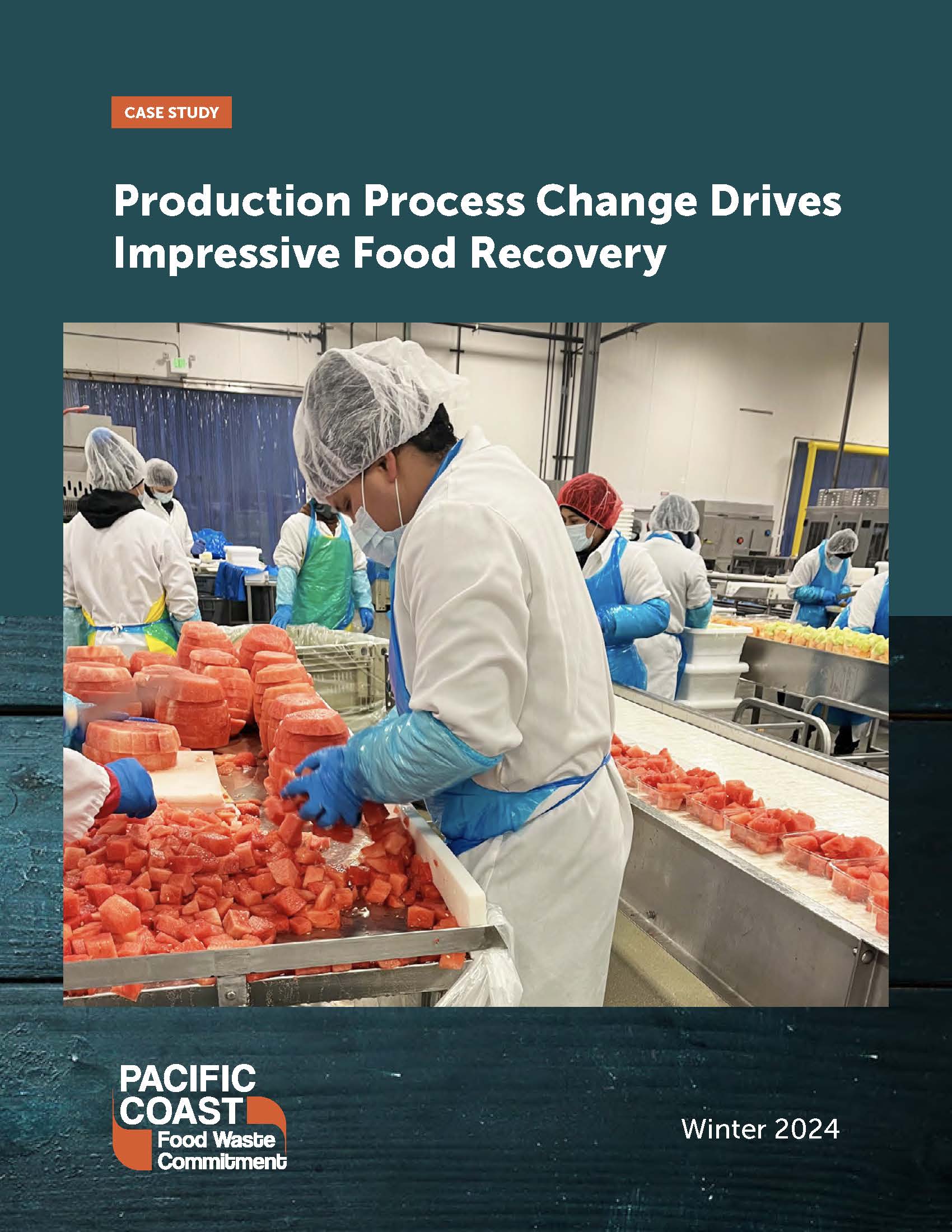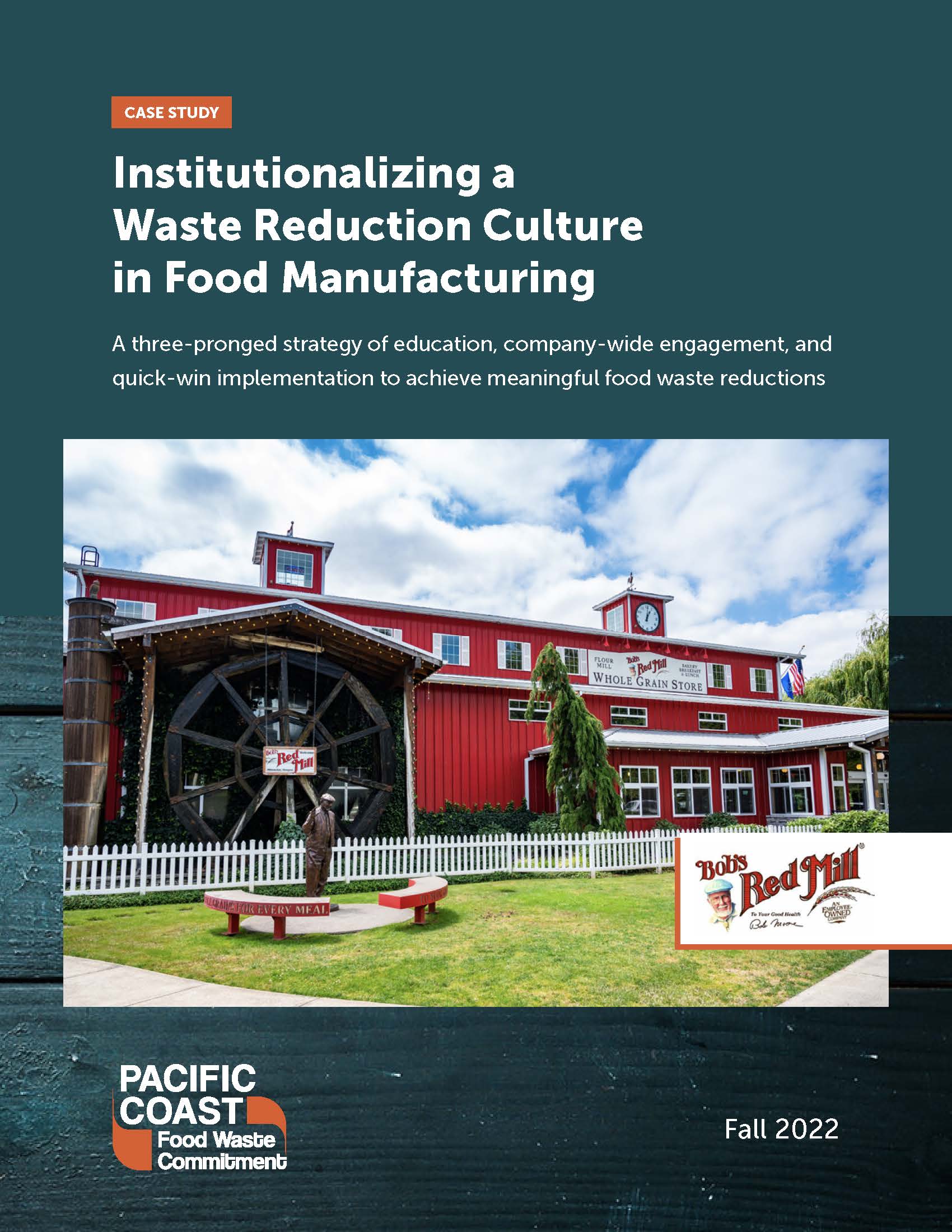
A FoodWISE Approach to Reducing Food Waste
Empowering Staff in Foodservice for Sustainable Impact
June 20, 2025
In this case study, the R&DE Stanford Food Institute, with support from Aramark, the Menus of Change University Research Collaborative, and Sodexo, piloted employee engagement projects in 10 different corporate and collegiate kitchens across the country, generating over 100 food waste reduction ideas and building sustainable cultures through frontline worker engagement.
This work resulted in:
215 employees engaged across all sites.
179 pre-surveys and 81 post-surveys were completed.
181 employee idea submissions.
120+ consolidated ideas.
Site Case Studies
Listed below are highlights, by participating sites, of the selected pilot idea and site-specific learnings and outcomes. These case studies provide tangible perspectives on the efforts undertaken by the participants.
1 SITE: R&DE Stanford Dining, Hospitality & Auxiliaries PILOTED IDEA: Training on Cooking and Holding Vegetables
R&DE Stanford Dining, Hospitality & Auxiliaries (SDHA) are continually enhancing their high standards of quality, sustainability, and student satisfaction. The contest selected idea led to training initiatives focused on fine-tuning vegetable culinary techniques, which reflect their commitment to continuous improvement and passion for delivering exceptional dining experiences for the Stanford community.
These refinements have been met with enthusiasm from students, some of whom have shared positive feedback to the team on the freshness and vibrancy of vegetables. “Optimal visual appeal, combined with vibrant texture and deliciousness, make it more enjoyable for students to incorporate vegetables into their meals”, Chef Andrew Mayne, Senior Associate Director of Culinary Excellence, shared. This has led to a noticeable reduction in plate waste reported by the team, supporting our broader efforts to minimize food waste across campus. As a result, staff have noticed an uptick in vegetable consumption, a win for both wellness and sustainability.
Equally inspiring has been staff’s engagement throughout this process. Their collaboration across stations has strengthened teamwork and creativity in ingredient use. Team members appreciate being involved in the “why” behind a change in practice and take pride in shaping solutions.
This type of initiative strengthens SDHA’s leadership in campus dining, where every enhancement builds on a legacy of culinary excellence and student centered services.
15 participants submitted 17 ideas, demonstrating strong engagement.
2 SITE: University of North Texas (UNT) PILOTED IDEA: Vegan Mayo from Aquafaba
At the University of North Texas, the winning idea centered on creating plant-based mayo from garbanzo bean liquid (aquafaba), a simple yet effective way to reduce waste and expand plant-based dining options. This initiative not only aligned with the university’s commitment to sustainability but also fostered greater employee engagement, as Chef Rodrigo Blanquet Suarez noted, “There is an enthusiasm about food waste among associates now.”
With 25 participants and 17 ideas submitted, the pilot led to the implementation of several new waste reduction practices, many of which will become permanent initiatives moving forward. Although UNT does not use a dedicated waste tracking tool, the pilot emphasized the importance of accurate forecasting and data entry, encouraging more consistent tracking within their existing food management system.
The program’s success has also prompted UNT to expand the training to four additional dining halls, integrating it into daily training sessions starting in the fall semester. This broader rollout aims to reinforce the impact of the pilot and sustain momentum in food waste reduction efforts across the campus dining network.
3 SITE: Vanderbilt University PILOTED IDEA: Exploring Initial Steps in Food Waste Reduction
At Vanderbilt University, the FoodWISE training successfully engaged 11 staff members who began taking a more proactive role in waste prevention. Although the site faced logistical constraints that limited idea submissions to two, managers observed a meaningful cultural shift: employees are now more attentive to waste points and motivated to suggest practical improvements.
The training sparked valuable discussions and highlighted the importance of clear implementation guidance, which will inform future efforts. Staff recommended more structured follow-up and instructor support to translate their growing awareness into concrete actions. This pilot laid the groundwork for a stronger waste tracking culture and positioned Vanderbilt’s dining team to adopt employee-driven solutions in the future.
The leadership team is building on this momentum by enhancing staff training resources, providing roadmaps for idea testing, and integrating waste reduction conversations into daily operations—ensuring that employees feel empowered and equipped to turn insights into impact.
1 SITE: Sun Devil Hospitality at Arizona State University PILOTED IDEA: Repurposing Trims for Stock
The piloted idea involved saving vegetable and chicken trimmings to make stock, transforming what would otherwise be discarded into a valuable kitchen staple. The initiative had a measurable impact, with one executive chef estimating that they repurposed an additional ten to 15 pounds of food per day, totaling approximately 200 pounds over the course of the pilot. The training fostered greater awareness of waste, and employees began proactively sharing creative ideas, such as using pineapple cores to make infused water.
Sun Devil Hospitality at Arizona State University’s West Valley Campus also utilized a tablet called ENABLE+ to track savings, helping the team connect daily practices with tangible outcomes. This combination of culinary creativity and data tracking made this pilot a strong example of how operational awareness can translate into consistent food waste reduction.
With 40 participants and 46 ideas submitted, Sun Devil Hospitality stood out as one of the most engaged sites in the pilot.
2 SITE: Boston University PILOTED IDEA: Bite-Sized Desserts and Adjusted Portioning
Boston University Dining took a creative approach to tackling plate waste, the biggest contributor to food waste on campus as a part of the FoodWISE pilot. The winning pilot idea introduced bite-sized desserts at the dessert station. Another idea focused on the sauté station and the use of smaller spoodles to help manage ingredient portions more precisely.
“These simple changes required minimal cost and operational adjustments, but they have the potential to drive meaningful reductions in food waste given the volume of meals we serve daily,” shared a member of the BU Dining team.
To measure impact, BU Dining tracked pre-consumer waste with Leanpath and hosted several “Weigh the Waste” events to monitor plate waste. The team noted that a longer implementation window would allow for even greater impact on future pilot programs.
Student employees played a key role by helping frontline associates submit ideas, resulting in 12 thoughtful submissions. Despite limited training time, engagement was high, and the pilot generated valuable insights. Staff also appreciated the training component, calling it a worthwhile addition to ongoing efforts to raise awareness and reduce food waste.
3 SITE: University of Vermont PILOTED IDEA: Waste Tracking Chart
The team introduced a station-specific waste tracking chart, allowing staff to log daily waste by item and adjust production accordingly. This initiative directly tackled overproduction, a key contributor to food waste. Melissa Mayo, UVM staff member emphasized, “Seeing the waste visually on a chart makes it easier to take action.”
Beyond this, the team also established a food donation partnership, freezing surplus prepared food for weekly pickup by a local food shelf—ensuring food that couldn’t be reused internally still went to good use.
The training had a clear and measurable impact on food waste tracking. During the pilot (Oct–Nov 2024), UVM logged over 550 Leanpath transactions, tracking 5,600 pounds of compost valued approximately $8,200, a dramatic increase from the 100 transactions and 1,000 pounds ($1,800 value) logged during the first five weeks of the semester. Compared to the same testing period in 2023, when only 470 pounds of compost were tracked across 50 transactions, the improvement was even more striking. The team attributes this jump in part to operational ramp-up, but also strongly believes that training and incentives led to greater employee engagement with the Leanpath system.
With 12 participants and six post-pilot survey responses, the site reported a significant boost in team morale and positive attitudes toward food waste reduction, underscoring the importance of combining practical tools, visual tracking, and meaningful follow-up in driving long-term change.
1 SITE: Confidential PILOTED IDEA: Shared Shelves Initiative
At a corporate site in Virginia, the winning idea was the Shared Shelves Initiative, allowing kitchen stations to share surplus ingredients, such as sliced tomatoes between the deli and salad stations. The team converted a large rack in the walk-in cooler into a shared usage space, encouraging staff to repurpose excess ingredients creatively. This initiative fostered teamwork and reduced unnecessary waste, resulting in new menu items like antipasto boards, cabbage boards, and fruit sangria created from shared products.
The impact extended to shifts in staff behavior, as Chef Zachary Viohl noted, “We’ve had multiple instances of staff finding different ways to use leftover product for new purposes. This has provided a home for food that would have otherwise gone unused.” Additionally, “Taking the stigma of waste away has opened the door for multiple conversations about usage.”
Data tracking during the pilot showed a measurable reduction in back-of-house food waste per transaction. The average waste per transaction went from $0.17 and 2.51 ounces of food waste in the baseline period (February to July 2024) to $0.14 and 2.42 ounces during the implementation period in October 2024. This decrease reflects both increased monitoring and a heightened focus on repurposing ingredients, driven by the shared shelves initiative.
The site had 31 participants, with 21 employees submitting ideas and a 10/10 recommendation score for the training. The team has continued to implement the Shared Shelf Initiative and has seen further waste reduction in the café. Moving forward, the team recommended expanding training on waste tracking and knife skills, emphasizing cross-station collaboration to further reduce trim waste.
2 SITE: Confidential PILOTED IDEA: Pop-Up Station for Expiring Ingredient
The Pop-Up Station for Expiring Ingredients allowed staff to find creative uses for surplus ingredients. This approach encouraged collaboration across stations, as the pizza station used leftover proteins from other areas, and the salad bar became a destination for repurposed foods.
However, the site noted challenges in data tracking, relying on an Excel spreadsheet instead of a web application like LeanPath. One participant suggested, “A daily check on production waste would be easier than the weekly check.” Despite this, the pilot successfully reduced waste, with 20 lbs of poke, 30 lbs of eggs, 30 lbs of brisket, and 120 vegan tacos saved through the initiative.
With 35 participants and 25 employees submitting ideas, the initiative showed strong engagement.
3 SITE: Confidential PILOTED IDEA: Freezing for Portioning
The site elected to freeze incoming ingredients in portioned amounts to reduce waste and streamline preparation. Service waste decreased by 18%, while storage waste temporarily increased due to the learning curve of implementing the freezing strategy.
One key insight was the role of leadership in waste reduction efforts, as employees noted that managers were often too busy to fully support sustainability initiatives. To maintain engagement, the team recommended introducing incentives for idea submissions and a scoreboard to track waste reduction efforts.
This site had a smaller group of six participants, and the training successfully shifted awareness and behaviors around food waste.
4 SITE: Confidential PILOTED IDEA: Product Utilization Board – Whiteboard Posted in Common Space
The selected idea was a whiteboard system to list surplus ingredients that needed to be used. The board is segmented into 3 sections: Freezer Items, Prepared Items, and Produce. This simple solution significantly improved communication and awareness, particularly across different shifts. The initiative sparked creative culinary adaptations, with teams designing specials/Pop-ups around available ingredients and better utilizing salad bar components.
Despite some uncertainty about whether behavioral shifts stemmed from the pilot or from changes in food waste tracking systems, employees observed “far fewer food scraps in landfill bins.” Notably, even employees facing a language barrier felt encouraged to contribute, signaling stronger engagement. Bi-lingual associates also regularly translate items posted on the board for accessibility.
The initiative showed strong engagement with 28 participants and 19 employees submitting ideas. The results of the grading/scoring conversation yielded many viable ideas that may have yielded equally favorable results. The site intends on revisiting the not selected ideas for implementation for a more synergistic approach to reducing food waste.
Resources
This pilot generated a number of resources that can be used by foodservice operators to run an employee engagement project of this kind. These resources include training materials, educational materials, and a full list of ideas from the pilot.
These resources provide the basics for running a successful employee engagement program in foodservice.
Making Food Waste Personal
A primer on how to make a large-scale food waste reduction effort personal.
Training Checklist
A comprehensive check list of what you'll need before, during, and after a FoodWISE training.
Contest Instructions
An overview on how to run the contest and the criteria for what makes an actionable food waste reduction idea.
FoodWISE Contest Welcome (English)
An introductory document to use when speaking to employees at the beginning of the competition.
FoodWISE Contest Welcome (Spanish)
Un documento introductorio para utilizar al hablar con los empleados al comienzo de la competencia.
FoodWISE Idea Hub
Can’t run a full-scale competition right now? Check out the Idea Hub, a catalog of the food waste reduction ideas generated by FoodWISE pilot participants.
These resources are critical to the engagement and idea generation phase of the employee engagement program.
Idea Submission Form (English)
The document where frontline workers will log their food waste reduction ideas. Tip: print out many!
Idea Submission Form (Spanish)
El documento donde los trabajadores de primera línea registrarán sus ideas para reducir el desperdicio de alimentos. Consejo: ¡imprime varias!
Pre-Training Survey (English)
A survey for frontline workers to take before receiving food waste education and completing the FoodWISE competition.
Pre-Training Survey (Spanish)
Una encuesta para que los trabajadores de primera línea completen antes de recibir educación sobre el desperdicio de alimentos y completar el concurso.
Post-Training Survey (English)
A survey for frontline workers to take after receiving food waste education and completing the FoodWISE contest.
Post-Training Survey (Spanish)
Una encuesta para que la completen los trabajadores de primera línea después de recibir educación sobre el desperdicio de alimentos y completar el concurso.
These resources are tools for management and frontline staff to support the day-to-day processes of an employee engagement program.
Huddle Cards (English)
Huddle cards include daily education and training for the duration of the FoodWISE contest. They are for management to distribute (physically or verbally) to frontline staff each day.
Huddle Cards (Spanish)
Las tarjetas de reunión incluyen capacitación y formación diaria durante el concurso FoodWISE. La gerencia las distribuye (física o verbalmente) al personal de primera línea cada día.
EPA Wasted Food Scale (English)
EPA's Wasted Food Scale is a curved spectrum showing options for reducing the environmental impacts of wasted food, from most preferred to least preferred.
EPA Wasted Food Scale (Spanish)
La escala de desperdicio de alimentos de la EPA es un espectro curvo que muestra opciones para reducir los impactos ambientales del desperdicio de alimentos, desde la más preferida hasta la menos preferida.
Food Waste in the U.S. Fact Sheet
ReFED's Fact Sheet is a snapshot of the extent and impact of food waste across the United States.
These resources provide tools and tips for supporting employees with continuing food waste reduction efforts at home.
FoodWISE at Home (English)
Additional resources for frontline workers to utilize and apply at home during and after the FoodWISE contest.
FoodWISE at Home (Spanish)
Recursos adicionales para que los trabajadores de primera línea utilicen y apliquen en casa durante y después del concurso FoodWISE.
Similar Case Studies
These case studies detail the success of completed intervention projects and how successful an employee engagement strategy can be to reduce food loss and waste.

Case Study
Leveraging Employee Engagement to Reduce Food Waste and Build a Lasting Culture of Sustainability at Kozy Shack
June 12, 2024
Employee Engagement:
A Key to Success
Engaging employees in food waste reduction initiatives creates a powerful, organization-wide commitment to sustainability. Employees are often closest to the daily operations where waste occurs and can identify inefficiencies or opportunities for improvement. Empowering them to take ownership of solutions transforms food waste reduction from a top-down mandate into a shared mission.


